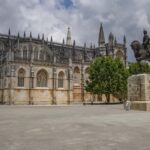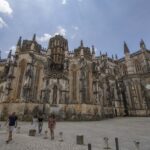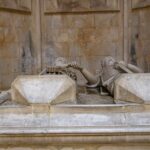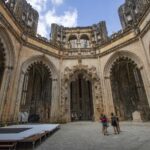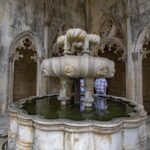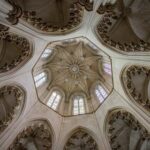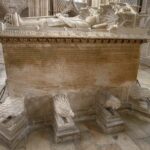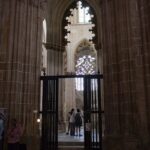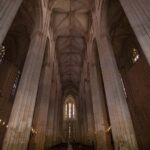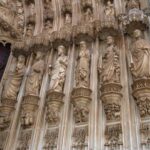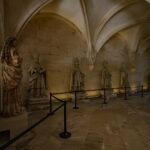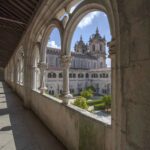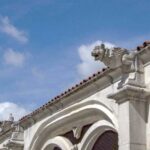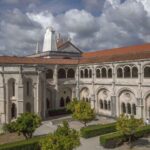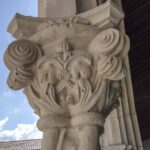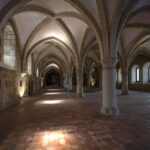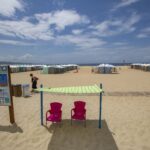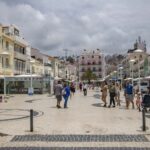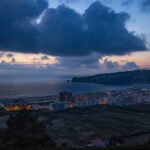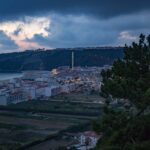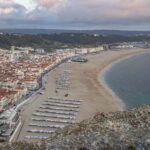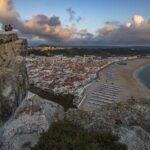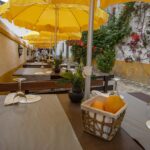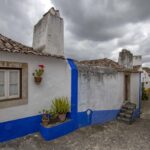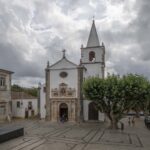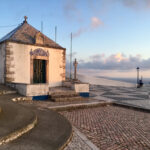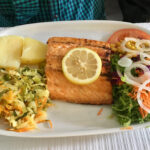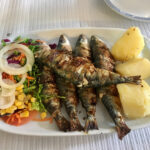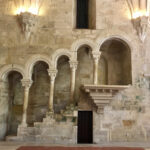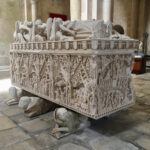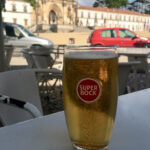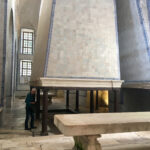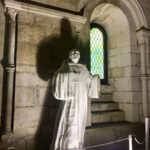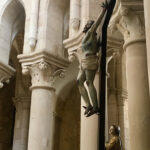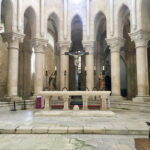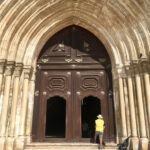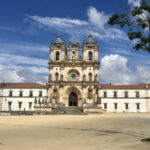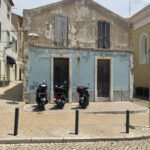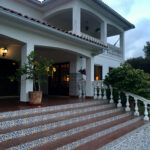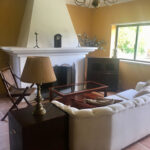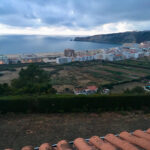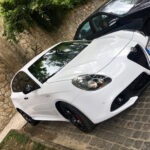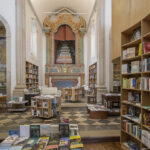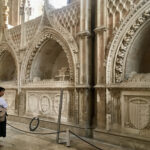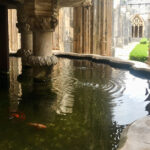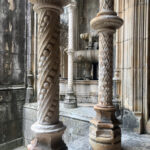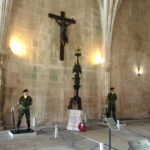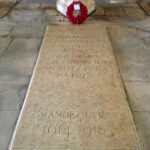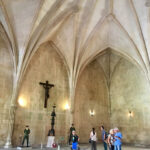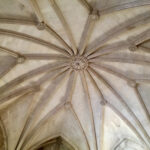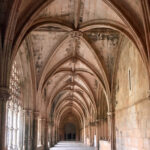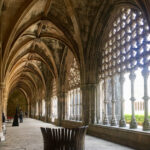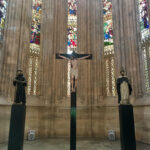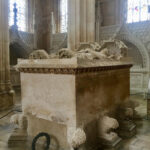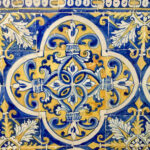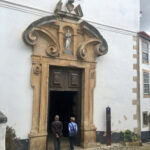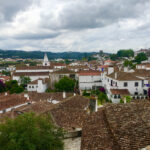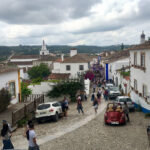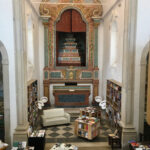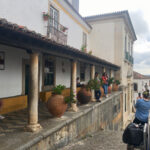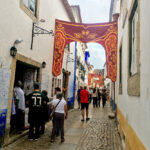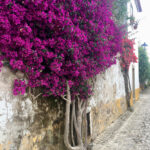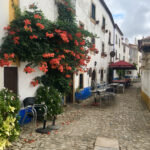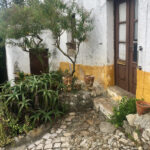Portuguese road trip in an Alfa Romeo Giulietta – living the dream! From our stately B&B in Sintra, we headed north to Nazaré via Obidos.
Obidos
There is not much to see here apart from the old walled town itself, but it’s worth a fleeting visit. Obidos is small and there are no striking UNESCO World Heritage Sites or sprawling town squares. The one, long main street is like a Disneyland medieval town, teeming with tourists jostling to try the local cherry liqueur that can be drunk from a glass or a tiny cup made of chocolate. There are embroidered tea towels galore, and all manner of Portuguese ceramics. But we left empty handed, taking only photographs against a grey sky, wishing that the sun would come out. I did love the converted church at the top end of town that now houses a bookstore. What a fantastic use of a pretty building!
Nazaré
By the time we got to Nazaré, it was time for lunch, but too early for check-in at our B&B, so we headed to the middle of the seaside town to find food. Parking is at a premium here, so we gave up any thought of a spot close to the action and instead settled for free parking in a vacant lot at the very top of the town, pretty much the farthest point from the beach. But it was only a 10 minute walk down hill to the seaside.
We headed to a legendary spot called A Tasquinha, a family owned and run seafood restaurant that is in all the guidebooks and ranks highly on TA. They were chockers, and we could’ve had a spot in half an hour (at the earliest), but we passed and headed elsewhere. This elsewhere was across the road and down one to Little India, excellent reviews on TA, and deservedly so! None of this bloody frozen vegetable bullshit for the mixed vegetable curry we endured at Pic Nic Indian Restaurant in Sintra (but I guess that’s what you get in an Indian/Italian combo restaurant). Little India in Nazaré used all fresh ingredients and was nice and spicy, as asked. Service was smiling, eager and friendly, and the complimentary pappadums and accompaniments were much appreciated.
After lunch we checked into our accommodation, Quinta das Rosas, up on the cliff above the town of Nazaré. This is run by a mother and daughter team, both named Anna, who are Canadian/Portuguese and speak a handful of languages each. They were delightfully smooth and unobtrusive in their hosting, which made our stay so pleasant. We were on the top floor of their house with wonderful views over Nazaré.
Alcobaça
We took the advice of Anna and Anna and headed to nearby Alcobaça to check out the monastery (Santa Maria, which is the same name of the monastery in another nearby town, Batalha). It was astounding to see such a gigantic complex in this small town. Apparently, the monastery was built first and as a result, industry came, and so a town grew around it. It was different to the monastery in Belém, but equally magnificent. This is the country’s largest church and the best Gothic building in Portugal.
The tombs of Dom Pedro and Inês, Portugal’s most tragic romantic couple, lie in this monastery. “They rest feet-to-feet in each transept, so that on Judgement Day they’ll rise and immediately see one another again” (Rick Steves). [Click here for more on the story of Pedro and Inês.]
A Tasquinha
On the suggestion from our hosts (and from our own research), we headed back to A Tasquinha for dinner. Anna had left a message on their machine asking for a spot for us at 7pm when they opened. She had told us that she might not be able to contact them, but to turn up just before 7, which we did, and arrived when the staff were finishing their own dinner. Just on 7pm, Carlos, the owner opened the doors and came over to shake hands and clasp us on the upper arms (in that lovely friendly European way). He knew who we were and gave us a choice of many seats. This man knew how to work the room and made every single guest feel special. He made suggestions for us and wasn’t at all fazed when we couldn’t finish our meal and asked for it to be bundled up for us to take home. He brought a whole bunch of small things to the table, and said if you don’t want, don’t have, so we left the bread and cheese, but couldn’t ignore the garlic olives or the fresh prawns, which were unlike anything I have ever tasted before – pure seafood, no salt, no sauce, no dressing, just deliciousness.
Then we made the mistake of ordering a salad (well, THAT wasn’t the error!), as well as two more dishes – one salmon and one sardines. The sardines were very reasonably priced, so I assumed that it would be a small portion. SOOOOOO wrong! We could’ve had John’s salmon solo (which came with salad and potatoes) and not a skerrick more and would’ve been full! But the food could not be faulted, or the service, just our ambitious appetites.
From there we drove to the top of the opposite cliff for sunset. Nearly didn’t go because we had missed the perfect light of the sunset, but glad we did. All we had was a moment or two, but the following night was overcast and rubbish for photographs, so it was a good call.
Batalha
The next morning, we set out for Batalha, which provided us with the THIRD extraordinary monastery of this trip (and the second to be named Santa Maria – the first was in Alcobaça). This one had the Portuguese tomb of the unknown soldier there, and we were fortunate enough to have been there when they were doing the changing of the guard.
This monastery, just like the previous one, has an amazing story attached regarding the monarchy and their loves. The women who married into this family were big time feminists. Philippa of Lancaster (granddaughter of England’s King Richard II) who married João I was intelligent, educated and moral. She impressed her husband by “overseeing domestic policy, boosting trade with England, reconciling Christians and Jews, and spearheading the invasion of Cuenta (1415) that launched the Age of Discovery” (Rick Steves). This royal couple were the head of a dynasty that had a huge impact on the world in this era.
In the Founders’ Chapel, centre-stage, is the double-sarcophagus of King João I and his English queen, Philippa. “The tomb statues lie together on their backs, holding hands for eternity. This husband-and-wife team ushered in Portugal’s two centuries of greatness” (Rick Steves).
The food on this trip has been surprisingly tasty – we had been warned about the limited options for vegetarians in Portugal, with a few more choices if dipping our toes in pescatarian waters. The trick was in ordering a bunch of sides, rather than mains. Our lunch was had just opposite the exit from the monastery at Burro Velho. We went with a mixed salad, sautéed vegetables and sautéed cabbage with corn bread and black eyed beans. Yay for the vegetarian sides, and while these were just sides, they were as filling as hell! Our evening meal after our leisurely drive back to our clifftop retreat was had on our balcony – sweet, sweet tomatoes, cucumbers and cheese.
From our room and balcony we could hear the waves, the seagulls, the children playing, the music, the calling out, the motorbikes revving. All this could be heard from down in the town. From right outside our window, we could hear the chickens and peacocks. The sea breeze was a delight. Some people commented about the lack of airconditioning at this accommodation, but I have trouble understanding the need for it. We then enjoyed the light show sitting up in bed watching the lighthouse flash across the harbour and up the cliff.
Next, on to Coimbra…
Accommodation: Quinta das Rosas
Click on any image below to view as gallery
- Statue outside Santa Maria Monastery in Batalha, Portugal
- Santa Maria Monastery in Batalha, Portugal
- Joao I and Philippa sarcophagus – holding hands for eternity in Santa Maria Monastery in Batalha, Portugal
- The unfinished chapel in Santa Maria Monastery in Batalha, Portugal
- Fountain in Santa Maria Monastery in Batalha, Portugal
- Vaulted ceiling of Santa Maria Monastery in Batalha, Portugal
- Sarcophagus in Santa Maria Monastery in Batalha, Portugal
- Interior of Santa Maria Monastery in Batalha, Portugal
- Nave in Santa Maria Monastery in Batalha, Portugal
- Statues in Santa Maria Monastery in Batalha, Portugal
- Statues of popes in Santa Maria Monastery in Alcobaça, Portugal
- Cloister arch view of the church at the Santa Maria Monastery in Alcobaça, Portugal
- Gargoyles in the Santa Maria Monastery in Alcobaça, Portugal
- Cloister of Santa Maria Monastery in Alcobaça, Portugal
- Column carving, Santa Maria Monastery in Alcobaça, Portugal
- Interior of Santa Maria Monastery in Alcobaça, Portugal
- Nazare Beach, Portugal
- Promenade at Nazare Beach, Portugal
- Evening wide shot of Nazare, Portugal
- Evening view of the town from our balcony, Nazare, Portugal
- View of Nazare Beach from the Belvedere, Nazare, Portugal
- View from the Belvedere at dusk, Nazare, Portugal
- Oranges on restaurant tables ready for lunch, Obidos, Portugal
- Backstreet in Obidos, Portugal
- Nic and John selfie in the main street of Obidos, Portugal
- Tourist ceramics galore in Obidos, Portugal
- The church of St Mary and the town square of Obidos, Portugal
- Salmon at A Tasquinha, Nazare, Portugal
- Freshly caught and grilled sardines at A Tasquinha, Nazare, Portugal
- Stairs leading to nowhere in Santa Maria Monastery in Alcobaça, Portugal
- Sarcophagus in Santa Maria Monastery in Alcobaça, Portugal
- Beer outside the Santa Maria Monastery in Alcobaça, Portugal
- Huge fireplace in Santa Maria Monastery in Alcobaça, Portugal
- Shadowy figure in Santa Maria Monastery in Alcobaça, Portugal
- Crucifix in Santa Maria Monastery in Alcobaça, Portugal
- Altar in Santa Maria Monastery in Alcobaça, Portugal
- Entrance of Santa Maria Monastery in Alcobaça, Portugal
- Exterior of Santa Maria Monastery in Alcobaça, Portugal
- Peeling paint and motorbikes, Nazare, Portugal
- The steps of Quinta das Rosas, Nazare, Portugal
- Sitting room of Quinta das Rosas, Nazare, Portugal
- View of Nazare from Quinta das Rosas, Portugal
- Alfa Romeo – Classic car symbol
- Interior of the Church of Santiago Bookstore, Obidos, Portugal
- Multiple sarcophagus in Santa Maria Monastery in Batalha, Portugal
- Goldfish in the fountain, Santa Maria Monastery in Batalha, Portugal
- Ornate columns, Santa Maria Monastery in Batalha, Portugal
- Guards at the tomb of the unknown soldier, Santa Maria Monastery in Batalha, Portugal
- Tomb of the unknown soldier, Santa Maria Monastery in Batalha, Portugal
- Crucifix and tourists, Santa Maria Monastery in Batalha, Portugal
- Cloister ceiling, Santa Maria Monastery in Batalha, Portugal
- Arches, Santa Maria Monastery in Batalha, Portugal
- Outdoor fire for heating in the cloister, Santa Maria Monastery in Batalha, Portugal
- Stained glass and crucifix in Santa Maria Monastery in Batalha, Portugal
- Joao and Philippa in Santa Maria Monastery in Batalha, Portugal
- Blue and yellow tiles, Obidos, Portugal
- Men admiring the architecture, Obidos, Portugal
- The rooftops of Obidos, Portugal
- View of the Rua Direita from the steps of the Church of Santiago, Obidos, Portugal
- View of the library ‘nave’ in the bookshop housed in the Church of
- Posing for photographs, Obidos, Portugal
- Main street of Obidos, Portugal
- Old bougainvillea, Obidos, Portugal
- Bougainvillea adorned restaurant, Obidos, Portugal
- Pot plants with character in Obidos, Portugal

